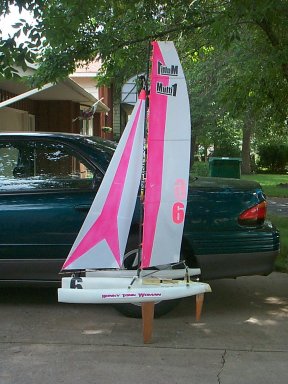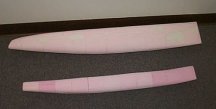last pictures concerning the sails’s Plan
Some time a little airblower may help !!
cheers
Claudio
Typical picture of Deck bonding !
Claudio
Hi Claudio,
I am again walking your steps, using the polystirene technic to build my Open60 1:20, but can’t find the ideal glue to bond the paper sheets on the polystirene slices…
What kind did you use ?
another question concerning the hot wire: did you use a piano string ? at what intensity ?
I found 10cm foam panels at Leroy Merlin, so didn’t have to bond them together.
here are some pictures showing my own version of Coreldraw and the slices of the growing master.
Thank you for giving us so many precious information !!!
Ciao,
Paulin
Bonjour Pailin,
the polystyrene can be glued/bonded with Epoxy . Most of the glues melt the foam.
The ‘hotwire’ is just a 0.4mm steel wire and the current it is adjusted around 1.5/2.0 amp.
This parameter is fonction on how you wish to cut in term of speed.
Good Work !
Waiting for the next pics
Cheers
Claudio
hi again,
“hotwire” OK ! but it doesn’t look nice…
Next step : Bonding and about 6 to 8 hours sanding
Cheers,
Paulin
Pauli , please go back to post n°2 . This is normal when it is done by hand. !
Ciao
Claudio



My 1 Meter trimaran built in 2002 using hot-wire foam sections, glued, sanded/shaped and then hollows filled before using as a male “plug” for fiberglass hull and floats.
Cladio,
i have been watching post #2 many times… and i think your job is better than mine.
i’ll have to sand it a little longer as i thought, but it doesn’t matter.
nice pictures Dick ! What do you think about the latest Alinghi & BMW Oracle racing ? Could be a new project. Or two.
Polystirene foam and hot-wire could easely produce the wing-sail of Oracle… just an idea.
cheers
Paulin
Paulin - nice to see multihulls recognized as legitimate sailboats for a change. I started on a 65cm multihull version of the “A” Class catamaran and shaped foam for hulls. I have started cutting ribs for a wing sail, but won’t be as detailed/elaborate as the BMWO wing. The hull design started last summer is based on the German FLYER design.
By the way, I have been in correspondence with a fellow who worked on ground crew for the trimaran - tending to the wing when not sailing, and some of the info provided is simply amazing … for instance - BMWO can lift the windward float AND the center hull in winds as light as 6 knots - yet they have sailed during training in winds in the range from 25 - 30 + knots. Hard to believe the wing is THAT powerful! He is helping Ray and I work on wings for our multihulls - Ray’s 2 Meter and my 1.2 Meter and 65cm.
Dick
Forgot to add photo - don’t want to hijack Claudio’s thread - just wanted to point out I have been using foam for some of my “plugs” for quite some time, and they come out very well.
Hi Dick,
don’t mind , the word polyester foam is part of the tread title.
Tell me please, observing the pictures of Alinghi and Oracle and now your model, what are de reasons to have the bow front line reversed ?
see red arrows in the pictures below:
Thanks
Claudio
The first of the 2 RG65, the TRAP65 is READY !
Tomorrow the first test in the water ! Finally !! the Batteries are loaded !!!
Cheers
Claudio
Great job Claudio ! and very quickly achieved.
i’m impatient to see it on the water. there may be a video.
i use your thread for the last time to show you the latest pictures of my master hull sanded. it looks great now !
many holes have to be refilled, but for my first polystirene experience, i’m quiet satisfied.
i’ll be there tomorrow to see Fuxia pictures.
Ciao,
Paulin
Hello Claudio,
The “reversed bow” started out as “something new” but those that started the trend thought it would allow the bow to “cut” through water and waves, reducing drag and also shedding the water. The problem for multihulls is when hitting a wave, and the wave makes it all the way to the cross beam, it slows the boat down. These designs originated to their current form in the International “A” Class , then the “C” Class and finally into the Extreme 40 class. The use proved to reduce the pounding of the bows over and down waves - and allowed the platform to sail “through” them. Keeping the platform of the boats steady, also reduce the “Hobby-Horse” issue as the boats went up the wave, or the top and then down the back. Imagine how much fore/aft movement took place at the time of a 10 meter mast. Each time the mast tip moves back, the wind pressure is lost for most of the upper part of the sail, then as the boat moves down the back of a wave, the mast tips and moves forward and air has to reattach itself to the sail to again “power up” the boat. By keeping the hulls somewhat level through waves kept the power on the sail. So the hull design reduced the pounding through the waves, reduced wave drag, and reduced the “Hobby-Horse” (or rocking horse) effect.
If you look at the hulls below the water line, they used a circular cross section forward to about mid-length, then the bottom begins to flatten out which helps the hull sail on top of the water and plane, as opposed to being submerged as a displacement hull. Add in curved daggerboards forward, which have a tendency to “lift” the bows, to reduce pitchpole, and they all seem to work together to improve the speed and handling of the boat.
As noted, having a “friend” on the inside of the organization allowed me to receive detailed technical information, performance information, and of course - photos - some of which were not published. Here are two of my favorites that Magnus provided.
Sorry, two questions i’ve just reminded:
I.i saw “slow polyester resin”( Soloplast Eco2 from Vosschemie) that polymerise in 50mn at 18°C and can be use for stratification with glass fiber or other… why do we only use Epoxy resin ?
II.i didn’t find the way to calculate the ideal lenght of the fin. could you tell me more about it ?
Thank you very much,
Paulin
Dick,
thank you very much for the sound explanation, rather soffisticated design concept approach.
Very nice the Oracle “golden” picture.
Cheers
Claudio
Hi,
I never used the 50 minutes resin for lamination, only for localised reinforcements or bonding of parts.
I use Epoxy, but others may use polyester. Polyester resin smell and scrink but it is cheaper.
The “ideal” fin nobody knows !
Empirically the fin surface should be about 6 to 7 % of the sail area , while the rudder should be around 30% of the fin area. Multihull uses smaller surfaces since are faster.
Again empirically , the fin width may vary from 7 to 9 % of the water line lenght (LWL).
Here again the “ideal” fin for your boat will be found during testing on the water.
Cheers
Claudio
Thanks, i’ll go back to the draftsman’s board to check it all.
regards,
Paulin
Little disaster today !!!
The 1st water test lasted only 10 minutes for my stupid fault.
I connected the receiver battery before switching On the transmitter. The winch pulled strongly the foward pulley retained by the elastic. The drum it is also damaged. Forced to get back home . total 150km for 10 minutes pleasure.
The 10 minutes were anyhow very rich with informations.
On the wind very fast and heeling some 30° with unstable gusting wind at 8/9 Kt
Easy to manouver even in choppy water .
Reaching with surprisingly very high speed, this is due to the fact that the main leading edge is further far away from the mast as was my design purpose to get read of mast turbulences.
Little running time to appreciate, but apparently good.
Returning back to my lab ! up to the next time !
Cheers
Claudio
Trap-65 is repaired and ready to go back to the water, meanwhile the
FUXIA 65 is back !
recovering the construction left some time ago !
Actually, after wet sanding, the surface is coated with paint filler aiming, just in case, to close the lamination porosity.
I let you knows …
Cheers
Claudio
Another bit referring to the rudder trunk bonding and 2 axis alignment !
Notice the 100g lead attached to the rudder blade to keep it vertically (1st axis) and squared with the hull . A water level serve to control the horrizon of the hull. Laterally (2nd axis) the hull is tilted in order to match the rudder and hull slope during trunk bonding.
Cheers
Claudio